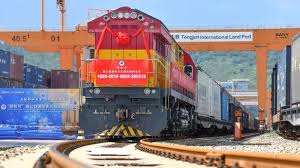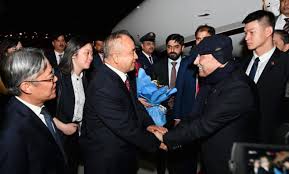EU enlargement: Illusion or reality?

In a show of solidarity following Russia’s 2022 full-scale invasion of Ukraine, the European Union offered the prospect of eventual membership to Ukraine, Moldova and Georgia, signaling to the Kremlin that these countries are not within its sphere of influence.
When United States President-elect Donald Trump returns to the White House in January, achieving NATO membership and obtaining the security guarantees that come with it will seem even harder for these nations. As a result, many of their citizens will likely view joining the EU as increasingly important. Yet there are many stumbling blocks along the way. These obstacles risk making the offer from Brussels of eventual membership an illusion and an empty gesture.
The appointment of a dedicated enlargement commissioner in the new European Commission, who will take office on December 1, aims to add credibility to the process. However, the reinstatement of this traditional role, covering candidates in Eastern Europe and the Balkans, will do little by itself to make EU membership a reality.

With risks and uncertainties overshadowing Europe’s future, three scenarios depict how the dilemmas of EU enlargement may play out in the years ahead.
Under this scenario, Ukraine, Moldova and Georgia, as well as Albania and the countries of the former Yugoslavia, gradually fulfill the conditions set by the EU and proceed toward membership. Turkey remains a nominal candidate, despite Ankara’s efforts to play off the EU, U.S., Russia, China and the Gulf countries against each other.
By 2035, Ukraine and Moldova manage to fend off Russian encroachment and adopt sufficient democratic and human rights reforms to convince the 27 EU governments that they are ready to join the union. An apparently lasting armistice between Ukraine and Russia persuades European governments that they are not importing instability when the country finally fulfills its European ambition. Russian President Vladimir Putin’s successor withdraws Russian forces from Transnistria, which becomes a semi-autonomous region of Moldova. Georgia, however, still vacillates between pro-Russian and pro-Atlanticist leaders and cannot yet be certified ready for membership.
To overcome problems in the membership talks, the EU agrees to 20-year transition periods before all EU rules apply fully to the new members. Restrictions on the free movement of goods, capital, services, workers and travelers are to be phased out slowly as countries demonstrate their ability to enforce EU principles and procedures. A reversibility clause enables the EU to suspend the benefits of membership in the event of democratic backsliding.
The EU takes the lead in supporting the reconstruction of war-damaged parts of Ukraine. This gives the commission and the European Investment Bank oversight of Ukraine’s fulfillment of European environmental, climate, energy and digital regulations, enabling Kyiv to get ahead in negotiating EU membership. The private sector bears the brunt of the cost with the EU and other donors providing the initial capital investment.
Germany, still tenuously ruled by a grand coalition of democratic parties, backs off from its previous demand that the national veto be abolished in the Council of Ministers on foreign policy and budget issues before further enlargement. Small European countries refuse to renounce the veto, their guarantee against edicts from Berlin or Paris. An upsurge of public opinion against floundering populist governments across the EU sweeps away remaining obstacles.
Under the successor of Serbian President Aleksandar Vucic, this pivotal Balkan country unequivocally opts for the EU in the late 2020s, despite sizeable Chinese investments and Russian advocacy of ethno-religious affinities. Serbia’s considerable administrative capacity, inherited from the former Yugoslavia, and its endowment of critical minerals, enables it to progress rapidly in membership talks.
Montenegro is the first to complete negotiations, followed by Albania, while it takes North Macedonia longer to convince the EU, and especially Greece and Bulgaria, that it poses no threat to their cultural and linguistic heritage and can take on the rights and obligations of EU membership.
Bosnia and Herzegovina, afraid of isolation, at last overcomes political deadlocks among the country’s main ethnic groups and implements the governance reforms demanded by Brussels. Serbia’s leaders restrain Republika Srpska from displays of separatism, permitting both countries to move forward toward EU membership.
The five previously reluctant EU member states finally recognize Kosovo as an independent sovereign state, deeming this a reasonable price to pay for the stability and security to be gained by admitting this querulous region into the union.
Thus, on May 1, 2034, 30 years after the EU’s big bang enlargement of 2004, eight candidate countries sign accession treaties and become full EU members on June 1, 2035 – albeit with lengthy, conditional and reversible transitional periods.
Unlikely: Insurmountable roadblocks
The second scenario takes a bleaker view of the prospects for EU enlargement. The EU greenlighted membership talks in record time in 2022-2024 to give a boost to Ukraine and Moldova in their struggles with Moscow. But this geopolitical decision ignored obstacles on both sides, including unresolved disputes between Poland and Ukraine going back to World War II, and complaints from Budapest about the treatment of Ukraine’s Hungarian minority.
Enlargement supporters underestimated both Russia’s resolve to curtail Ukraine’s independence and the challenge that complex EU regulations pose for Eastern European and Balkan countries. These countries still grapple with imperfect democracies, persistent corruption, ethnic tensions and disagreements with neighboring states. Within the EU itself, political and economic hurdles also exist, including concerns among farmers about competition from Ukrainian exports and worries about the impact of expansion on the EU’s budget.
In this scenario, hostilities between Ukraine and Russia grind to a halt in the years following Donald Trump’s return to office. But no political settlement or peace treaty is signed, as war aims still diverge. Instead, there is an uneasy ceasefire with the military positions of both sides frozen in eastern Ukraine and Crimea. Sporadic skirmishes continue across the demarcation line in the east. Russian forces still occupy the Transnistrian pseudo-state in Moldova as well as large enclaves in Georgia.
The Ukrainian and Moldovan governments insist that the EU refers in their eventual accession treaties to their entire national territories, even though a considerable part of these remains under Russian occupation. The EU considers as possible solutions the Cyprus model, with EU law suspended in the part of the island occupied by Turkey, and the German model, whereby the German federal states formerly under the German Democratic Republic became part of the EU after the fall of the Berlin wall in 1989. But these precedents fail to convince those who fear that the EU would be importing instability rather than exporting stability in admitting countries partially occupied by a hostile foreign power.
Italy insists that the Balkan countries’ membership bids should not be leapfrogged by Ukraine and Moldova, simply to send a message to Mr. Putin. But these countries remain mired in ethnic tensions, conflicts with neighbors, corruption, state capture and administrative shortcomings, with Russian and Chinese influence on the rise. So, progress toward EU membership is slow.
All candidate countries reject the EU’s proposal of long transitional periods, claiming that this would amount to second-class membership. They particularly resent the proposal for long-term EU supervision of democracy and the rule of law, arguing that this would be an infringement of their sovereignty.
The need for referenda in several EU countries, including France, to approve the outcome of the negotiations hangs like a Damocles sword over the entire process. The days when the public could be asked to vote again, or leave it to the diplomats, if voters misguidedly reject an EU treaty are over. Antipathy to enlargement lingers in EU countries still dependent on Russian oil and gas or with governments leaning toward Moscow.
In this scenario, target dates for completing the negotiations are repeatedly missed amid growing acrimony. As with Turkey, in the two decades after it opened membership talks in 2005, EU representatives accuse the candidates of failing to implement democratic reforms while the candidates accuse Brussels of insincerity. Russia and China step up disinformation and the illicit financing of political parties. The enlargement process stagnates, and enlargement-averse governments commission studies on alternative models for the EU’s relations with its near abroad.
By the late 2020s, in this scenario, policymakers conclude that the offer of membership was premature for countries that were de facto at war or otherwise unprepared for the rights and obligations of membership. The offer was made hastily as the EU’s geopolitical toolbox contained few carrots except enlargement and few sticks except sanctions. At the time, hopes were set on the EU becoming a geopolitical power and Ukraine was seen as contributing to European security with its battle-hardened army and armaments production, including advanced drones. But these arguments faded as it became apparent that Ukraine’s accession would bring new security risks due to persistent tensions with Russia.
Still, there could be no stepping back from the offer of membership once it had been made. The EU could not, for example, condition Ukraine’s accession on the signature of a peace treaty with Russia without handing a veto to the Kremlin.
In this scenario, therefore, the EU seeks to keep the prospect of eventual membership alive, while acknowledging that this might take many years, or even decades. Some argue that the EU itself requires an enlargement perspective – however distant – to avoid becoming inward-looking and to retain confidence in the attractiveness of its model, against the lure of the enlarged BRICS and the rejection by the Global South of the kind of human rights and climate conditionality the EU attaches to trade agreements and, of course, to membership.
This scenario, therefore, posits the continuation of open-ended accession negotiations, at a slow pace, combined with concrete support for the candidates’ efforts to modernize their countries in line with EU standards. The EU offers greater incentives for reforms by providing benefits up front as countries make measurable progress. This entails prior admission to the single market, access to EU funds for economic restructuring before membership, and observer status in EU institutions. These benefits are reversible in case of backsliding.
As in the second scenario, the reconstruction of Ukraine, once high-risk hostilities cease, is a major priority. But this scenario does not foresee new candidates joining the EU by the mid-2030s, with one possible exception.
Montenegrin Prime Minister Milojko Spajic claims that his country could join the EU by 2028. Montenegro’s membership would, arguably, cause scarcely a ripple with its 600,000 inhabitants, 7 billion-euro gross domestic product, (around 12,000 euros per capita) and an economy that already uses the euro as its currency.
But this hypothesis is not a given. The country has made progress in addressing key governance criteria, clearing the way to detailed negotiations in other areas. But recently pro-Serb and pro-Russian political parties have come to the fore and anti-EU parties have proposed a “foreign agent” act, similar to the one which led the EU to suspend negotiations with Georgia. The 2028 goal for membership seems over-optimistic. Anyway, the EU has yet to decide on whether the value of a mini-enlargement in reinforcing its credibility would outweigh the complications. Reforms to the EU’s own decision-making system, a condition set by Germany and others for any enlargement, are unlikely to be achieved in time for Montenegro’s early accession.
This scenario sees the EU offering incentives to candidate countries for continued reforms and the resolution of conflicts with neighbors, while keeping open the prospect of eventual membership. Incentives range from economic assistance to participation in specialized EU agencies and observer status in certain EU institutions. Partial political and economic integration becomes the new reality while actual membership, however hypothetical, remains the stated long-term goal.
Geopolitics versus merit
The EU offered eventual membership to Ukraine, Moldova, Georgia and other manifestly unprepared countries as a gesture of geopolitical solidarity. But the EU is a community of law, and the accession process is merit-based. This means that the first scenario, EU expansion within a decade, which is implicitly endorsed by European leaders, is highly improbable. The second scenario, insurmountable roadblocks, would represent such a setback for Europe and victory for Russia that EU leaders, despite their differences, would surely take measures to avoid it. Consequently, they will be tempted to make a little leap forward in the form of partial de facto integration, possibly accompanied by the early accession of a small Balkan country.





